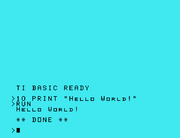TI BASIC (TI 99/4A)
TI BASIC is an ANSI-compliant BASIC programming language interpreter built into the 1981 Texas Instruments TI-99/4A home computer and its predecessor, the TI-99/4 (1979). TI Basic is based on Dartmouth BASIC and complies to the American National Standard for minimal Basic (ANSI X3.60-1978). Text, full screen graphics, logic operations, and recording to tape or any other file system, were supported by TI BASIC. Texas Instruments also produced TI Extended BASIC cartridge that enhanced the functionality accessible to BASIC users.
 | |
| First appeared | 1979 |
|---|---|
| License | Proprietary |
Elements of TI BASIC
Statements
The statements of TI BASIC are CALL, CLOSE, DATA, DEF, DIM, DISPLAY, END, FOR..TO..STEP, GOSUB, GOTO, IF..THEN..ELSE, INPUT, LET, NEXT, ON..GOSUB, ON..GOTO, OPEN, OPTION BASE, PRINT, RANDOMIZE, READ, REM, RESTORE, RETURN, STOP
Every line of TI BASIC can only contain one statement. The possibility to put several statements in a line with :: and also the necessary PEEK and LOAD calls to use assembly language routines became available in TI Extended BASIC. Note that there is no POKE statement in TI BASIC. Loading and executing machine code requires a 32K memory expansion and the TI Editor/Assembler or TI Mini Memory cartridge[1], which then gives access CALL LOAD. The 256 Bytes of RAM directly accessible by the CPU was mostly consumed by the BASIC interpreter. TI BASIC stored and ran programs from the 16K video RAM, and, unlike TI Extended BASIC, could not take advantage of the 32K memory expansion.
Functions
Unlike Microsoft BASICs, which used LEFT$, MID$, RIGHT$, and INSTR for manipulating strings, TI BASIC used the ANSI-compliant SEG$ and POS.
- ABS Absolute value
- ASC ASCII numeric value of the first character of a string
- ATN Arctangent
- CHR$ Convert a number into a string with an ASCII character
- COS Cosine
- EOF Test whether the end of a file has been reached
- EXP Exponentiation
- INT greatest integer less than or equal to the parameter
- LEN Length of a string
- LOG Natural logarithm
- POS First occurrence of a string in another string
- RND Pseudorandom number generator
- SEG$ Return a substring of a string
- SGN Sign function
- SIN Sine
- SQR Square root
- STR$ Convert a number to a string
- TAN Tangent
- VAL Convert a string to a number
Subprograms
Subprograms are called with CALL statement (e.g. CALL CLEAR). There are no user defined subprograms (this is possible in TI Extended BASIC), but some subprograms are predefined:
- CHAR Definition of graphical characters
- CLEAR Clears the screen
- COLOR Defines foreground- and background color for 8 characters
- GCHAR Reads one character at a specified position from the screen
- HCHAR Writes a character to a screen position and repeats it horizontally
- JOYST Returns the position of the joystick
- KEY Reads from the keyboard without echo on the screen
- SCREEN Changes the color of the screen
- SOUND Creates sounds (using a frequency) and noise
- VCHAR Writes a character to a screen position and repeats it vertically
Development
TI BASIC written in an interpreted byte-code language known as Graphics Programming Language which is unique to the TI-99 line. TI Extended BASIC improved execution speed somewhat by providing some functionality in assembly language.
References
External links
- Beginner's BASIC at ClassicCmp.org
- User's Reference Guide at ClassicCmp.org
- TI-99/4A BASIC Reference Card at ClassicCmp.org